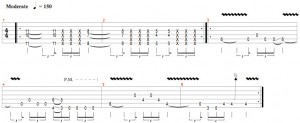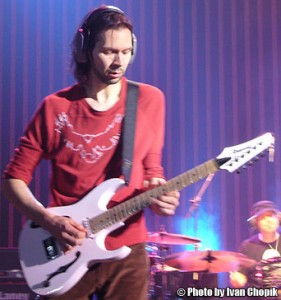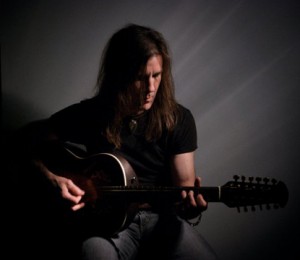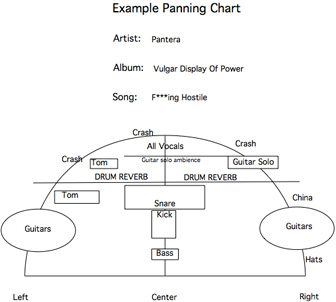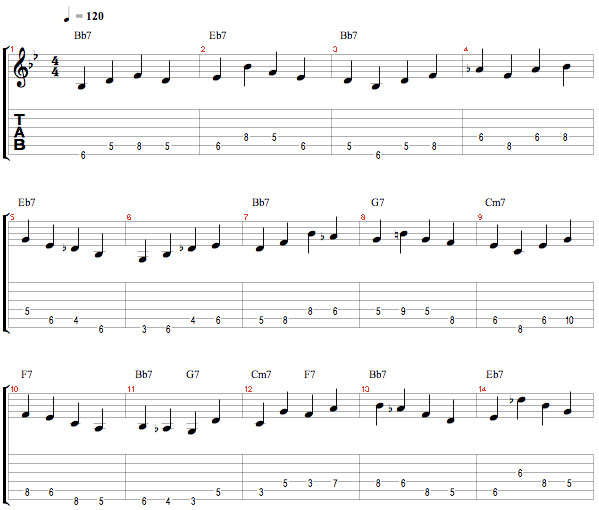[Devin’s Peavey guitar is tuned to Open B Tuning for all examples in this Masterclass: B F# B F# B D#].
Composition
I think that the instrument that you first become proficient with ultimately defines the way in which you write music. I do play an equal amount of bass guitar as I do 6-string guitar, and while the process is similar, it’s a little different because bass is coming from the role of support. But with guitar you’ve got the option of either rhythm or lead, so everything that I write (other than a few isolated bass moments) comes from me with a guitar in my hands. Writing involves me riffing at home or hanging out with people: my hands end up finding notes and melodies that are representative of these moments and their emotional significance to me.
I work with Pro Tools, Logic, Ableton Live, and all those standard DAW’s. I usually start with a click track. Then I start to jot down ideas that I’ve either documented on my phone or on a handheld recorder, and I see where it leads. The melodies that I wrote for Deconstruction or Ghost or anything that is not even for guitar, be it a vocal or a violin melody, are all still initiated with guitar. So the whole point here is that no matter what your primary instrument is, you are going to be able to compose with it. Whether it’s guitar or piano, the instrument that you choose is ultimately going to define your approach to music. And guitar? It’s rock ‘n roll, so there’s always going to be an element of that to what I do.
Open Tuning
I’ve always tuned to an open major chord. Typically, in the past I’ve always been in open C, but at some point a guitar was left in the sun and it ended up dropping down a pitch. Either the wood shifted or the neck moved and I ended up picking it up and it was in B without me actually being aware of it when I wrote a bunch of songs. And now I’ve got a bunch of songs in B, as well.
Typically my guitar was C-G-C-G-C-E which is an open C major chord, but I’m about half and half now so it’s B-F#-B-F#-B-D# – the same thing down a half-tone. The reason why chose this tuning, I guess, was a couple things:
First and most obviously was Led Zeppelin with the song ‘Friends’ off Led Zeppelin III. That song meant a great deal to me as a young kid. After struggling to learn it in standard tuning, I ended up in the open tuning and I was just too lazy to change it back. To be honest, I can’t really play much in standard tuning now at all.
I also like this tuning, because my writing always includes a lot of layering. I’ve always thought of things in an orchestral sense. I’ve always liked John Williams and Trevor Jones and [Igor] Stravinsky.
I use octaves pretty much exclusively while I’m writing riffs, because they don’t define a tonality. If the melodies in my head are meant to be minor or augmented or diminished, I’ve got just the roots in the rhythm section. Then I get a really solid foundation on the bottom and I can fill in the tonalities with all the other shit like vocals, keyboards, ambience, and orchestras.
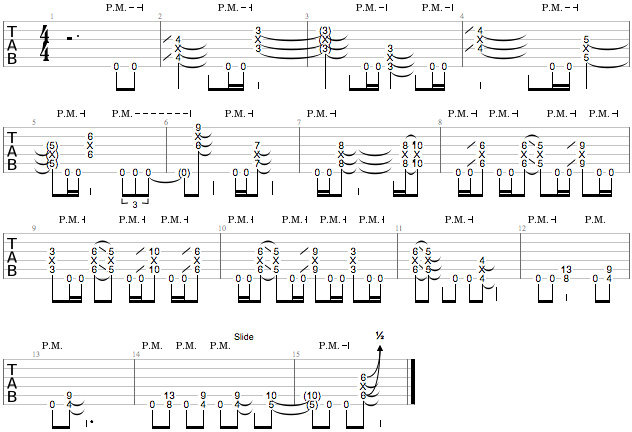
The reason I’ve chosen to write riffs like that as well, is because as a singer it’s easy for me to play without having to do elaborate sort of chord shapes, for the most part. Not saying I don’t do the chord shapes, because in this tuning your power chord shape that you have in Standard tuning [starting on the 5th string becomes a sus2 chord, 1-5-9]. And if you want to do a standard power chord on the low strings it’s [just one finger].
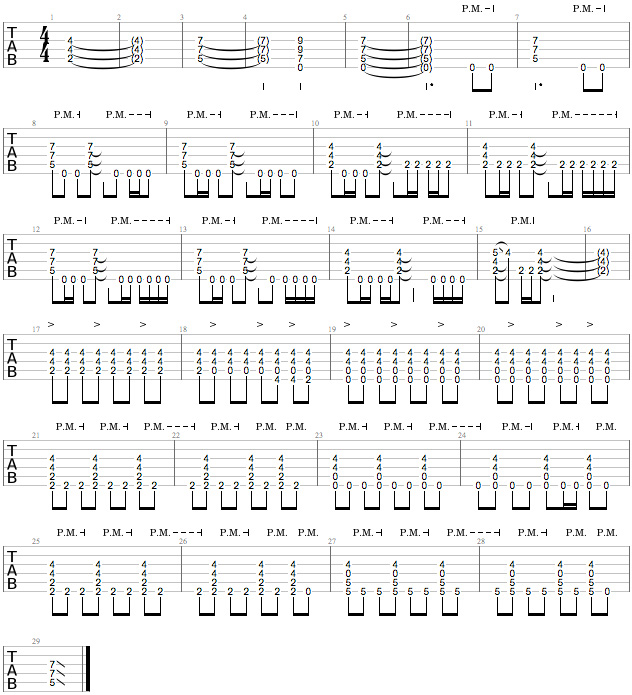
One of my favorite musicians is Ravi Shankar. I’m nothing like him, but I do draw influence from the sympathetic ringing of his sitar strings. I rely on the ringing of the open strings to work my riffs together. I like the idea of the last note I play affecting the next ones and I use a lot of echo.

Scales / Arpeggios
In this tuning, the way that scales and arpeggios work is pretty simple I would imagine, compared to standard tuning. Each string is basically the same thing as far as I can tell. I don’t really know theory, like at all. In fact, when we were doing the orchestral stuff, they’d be like ‘well, is that a C#?’ and I’m like ‘well, it’s the 7th fret.’ That didn’t really help.
MAJOR SCALE / IONIAN (NO 4)
[GM: Devin’s approach to scales provides for very comfortable fingerings and symmetrical patterns. He often constructs these patterns as 6-note, or hexatonic, scales whereby the 4th degree is omitted. Thus, his ‘major’ scale is just a standard major scale with the 4th note skipped: 1, 2, 3, 5, 6, 7.]

MINOR SCALE / DORIAN (NO 4)
[GM: Devin’s ‘minor’ scale follows the same formula as the Dorian mode without the 4th degree: 1, 2, b3, 5, 6, b7.]

1, b3, 3, 5, b7, 7 / 1, +2, 3, 5, +6, 7
[GM: The third Devin presents is a bit more unusual and complex. For the music theory aficionados out there, let’s attempt to analyze it! The scale has a very bluesy flavor to the ear, but digging deeper we can trace it back to a mode of the Double Harmonic Major scale. Harmonic Major is a major scale with a flatted sixth degree: 1, 2, 3, 4, 5, b6, 7.
Double Harmonic Major goes one step further by lowering 2nd degree, creating an augmented 2nd interval between the 2nd and 3rd degrees: 1, b2, 3, 4, 5, b6, 7. Thus, the SECOND MODE OF DOUBLE HARMONIC MAJOR can be spelled as: 1, b3, 3, 5, b7, 7, or 1, +2, 3, 5, +6, 7. Of course, this is just one way of analyzing the scale. Feel free to post a comment if you have other approaches!]

1, b2, 3, 5, b6, 7
[GM: The last scale Devin presents us with equally as complex as the previous and can be heard in a number of ways. We can approach again from Harmonic Major – the spelling of Devin’s scale is very similar except for the flatted second degree and omitted 4th degree, so we could call it HARMONIC MAJOR (b2 NO 4). Friends of Guitar Messenger and theory wizards CHRIS BUONO and PER NILSSON offered 2 further perspectives:
Diving into the world of Indian Classical music, Chris called the scale BHAIRON HEXTAONIC – “Bhairon is a raga that actually has seven tones: 1,b2, 3, 4, 5, b6, 7. The omission of the 4th throws it into the hex thing. In full form it’s also known as the Persian scale.”
Per approached the scale from the Hungarian Minor family of scales. Hungarian Minor is a Harmonic Minor scale with a raised 4th degree: 1, 2, b3, +4, 5, b6, 7. The 5th mode of Hungarian Minor is called Double Harmonic Minor: 1, b2, 3, 4, 5, b6, 7. “It’s called double harmonic, because it has two augmented seconds!” By using this scale and omitting the 4th degree, we arrive at Devin’s scale, which we can thus call DOUBLE HARMONIC MINOR (NO 4).]

It’s an easy way to get those scalar shapes going, because throughout the neck you’re just kind of rolling on similar shapes.
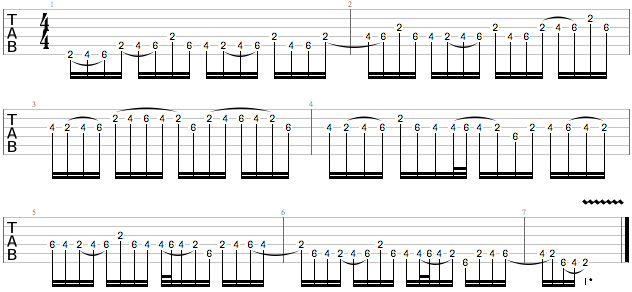
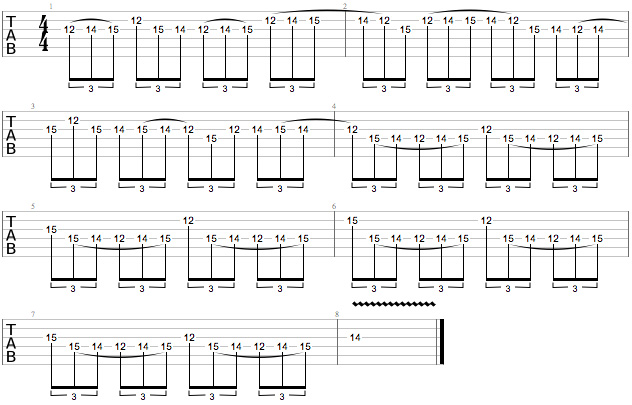
Same with arpeggios. What you end up having with this tuning is the same principle: it’s the same shape on two strings repeated up to the [second] highest string. I very rarely use the highest string, except for certain examples.

So it’s a very cool way to make shapes. I remember pissing around with them at some point with this song ‘Ki’ [title track from the 2009 Devin Townsend Project album Ki], and the melody ended up going like:
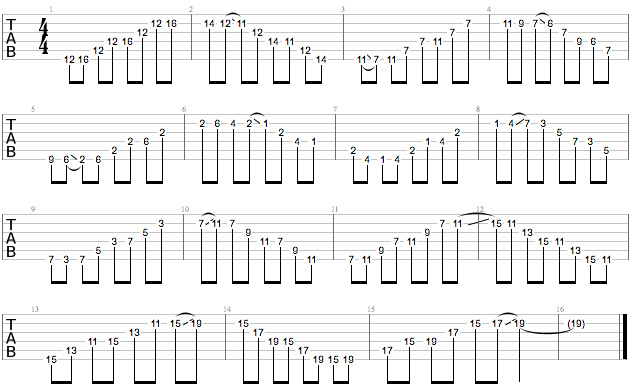
Technique
When I was 15, I think what defined my dedication to technique was that I wasn’t getting any sex. As a result of that I practiced a whole lot. It was like a dick swinging competition where everybody was trying to out-wank each other:

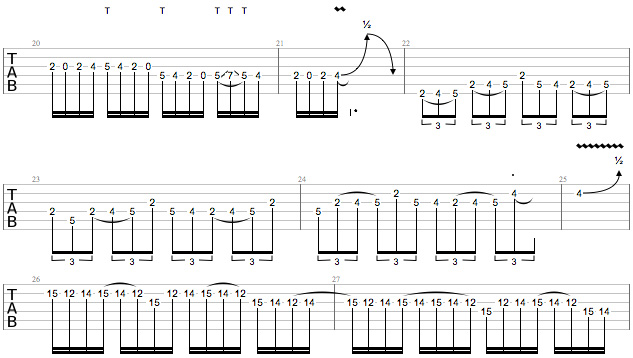

I was very fortunate when I was 19 to hook up with Steve Vai. I played and sang with him for several years. He’s an incredible guitar player, a fascinating musician, and incredibly theoretically proficient. He really knows his instrument and his notes. Not only does he know what he’s playing, but he knows why he’s playing it. That was never actually me. I have no idea what I’m doing and I think that’s been in a lot of ways very liberating for me, because there are no rules to break if there are no rules, right?
After a while of playing with people who were better than me and who really knew what they wanted to play, I found that I became tired of technique and the incessant practicing. I go through phases now and I’m actually currently going back to where I’m practicing guitar again, but for the past 8 months I’d been doing nothing but playing bass.
I think that that’s the interesting part of the instrument as well: when you’re interested in the guitar, the notes come easily to you in terms of lead playing, and when you’re disinterested in it, it becomes strictly a songwriting tool. In order to actualize the ideas that you have in your head, to know theory, all that time I spent as a teenager whacking off and learning how to sweep pick was probably a really good thing, in hindsight. When we went and did Deconstruction, there were a lot of really difficult things to play on that record. So when those ideas came to me as I was writing, I was able to do it. I think that, ultimately, that is incredibly liberating as an artist to have the faculty to do that.
So it’s a dual-edged sword: I think you should practice your balls off, but at the same time, I very rarely find a place in the song that I think ‘well, there’s a great place for a bunch of wanky guitar!’ I’d say for me, 98% of the time, some sort of creative melody is much more satisfying to both me and for the song.
Outro Improvisation
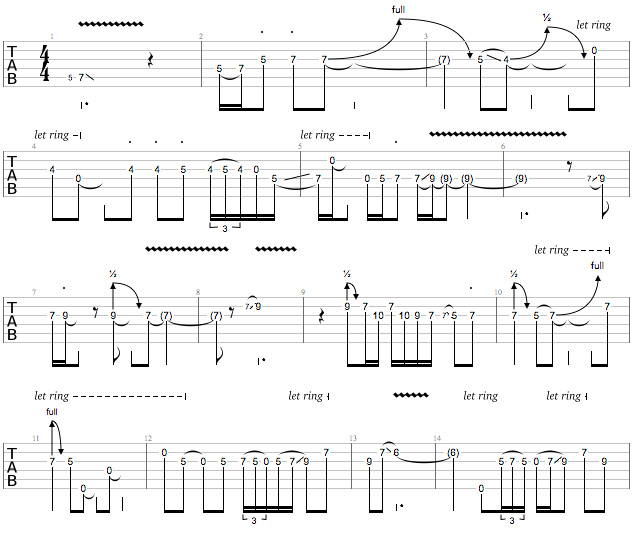

[Special Thanks Chris Thomas and Joe Mahoney for their excellent camera work, Devin Kumar for his fantastic video intro and editing, and Peter Boyle for his top-notch transcription work.]




